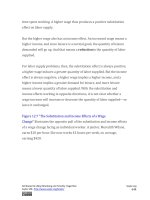Authors libby rittenberg 876
Bạn đang xem bản rút gọn của tài liệu. Xem và tải ngay bản đầy đủ của tài liệu tại đây (492.56 KB, 1 trang )
Case in Point: Do Consumer Protection Laws
Protect Consumers?
Economist W. Kip Viscusi of the Harvard Law School has long advocated
economic approaches to health and safety regulations. Economic
approaches recognize 1) behavioral responses to technological
regulations; 2) performance-oriented standards as opposed to commandand-control regulations; and 3) the opportunity cost of regulations. Below
are some examples of how these economic approaches would improve
health and safety policy.
Behavioral responses: Consider the requirement, imposed in 1972, that
aspirin containers have childproof caps. That technological change seemed
straightforward enough. But, according to Mr. Viscusi, the result has not
been what regulators expected. Mr. Viscusi points out that childproof caps
are more difficult to open. They thus increase the cost of closing the
containers properly. An increase in the cost of any activity reduces the
quantity demanded. So, childproof caps result in fewer properly closed
aspirin containers.
Mr. Viscusi calls the response to childproof caps a “lulling effect.” Parents
apparently think of containers as safer and are, as a result, less careful with
them. Aspirin containers, as well as other drugs with childproof caps, tend
to be left open. Mr. Viscusi says that the tragic result is a dramatic increase
in the number of children poisoned each year. Hence, he urges government
regulators to take behavioral responses into account when promulgating
technological solutions. He also advocates well-articulated hazard
warnings that give consumers information on which to make their own
choices.
Attributed to Libby Rittenberg and Timothy Tregarthen
Saylor URL: />
Saylor.org
876









